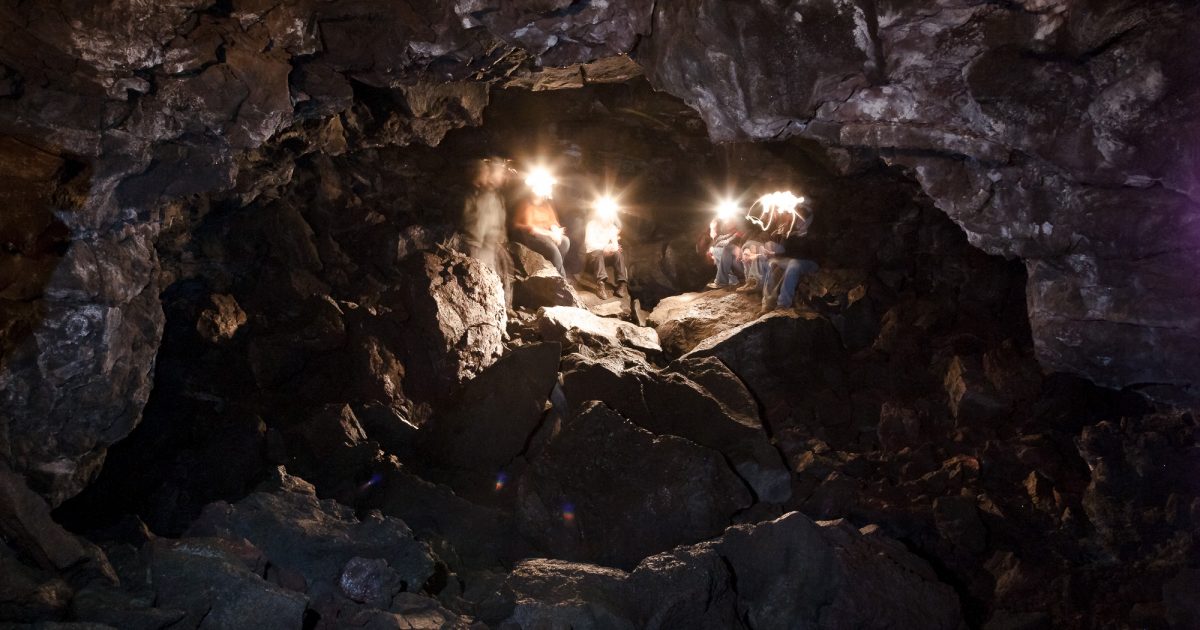Heading down under: ventures beneath the earth’s crust

Caving is an invigorating sport that allows participants to explore pristine areas rarely visited by humans. Cavers should wear old clothes, headlamps, knee pads, gloves, helmets and hiking boots. One woman’s experiences exploring a cave with a spelunking group are described.
As an ardent hiker, I’ve spent a lot of years walking on top of the earth. Now I want an intimate and rare glimpse of what’s under the crust. I want to travel deeper and deeper into a cave until I am inside a mountain.
Of course, caving isn’t nearly as accessible as hiking. For one thing, you don’t do it alone- for another, it requires more gear and expertise. My greenhorn expedition is well guided by third-generation caver Bruce Dunlavy and the Grotto, a York, Pennsylvania, spelunking group made up of four women and nine men.
It’s not as convenient, either: Dunlavy warns me to heed nature’s call before entering because you aren’t permitted to relieve yourself inside unless you have a container in which to carry out the results. Its role in filtering water makes this ecosystem one of the most sensitive on the planet.
The necessities taken care of, we file into the cave, wearing our oldest clothes (they’ll soon be caked with mud). A helmet, a battery-powered headlamp, knee pads, gloves and hiking boots with good tread complete my outfit. My fanny pack holds a bottle of water, snacks, and a flashlight with spare batteries and a bulb.

As we travel the first yards, the atmosphere quickly changes from the damp, raw cold of winter to a comfortable 50 degrees Fahrenheit. Groundwater seeping from the surface turns the dry dirt floor into a creamy orange clay. This is a “wet” cave, which means that it’s active and growing; minerals leave deposits and make formations as they filter through the cracks in the rocks. Yellows, oranges, browns, and whites surround me. My boots begin to squish and squeak in the mud as I crawl and pull my body through passageways.
The mud quickly cakes on my boots, and they lose traction. When I have to crawl through a narrow tunnel, thrusting elbows and toes forward and then levering them back, I’m grateful for the knee pads. Spelunking requires you to be much more aware of your body than hiking, cycling or canoeing does. There are lots of tactical decisions to make, each related to how you move your body. I’m enjoying this fresh slant on using mine and needing its various parts to communicate with each other as I execute my moves.
The atmosphere among the cavers is relaxed and friendly. Sometimes we split up to explore dead-end side tunnels. We wait for one another’s return, careful not to leave anyone behind.
Conversation flows freely despite the poor lighting that makes body language useless. Some of the cavers use battery packs in their headlamps; others swear by the traditional carbide lamps, which emit a softer, more diffuse light. When we sit to rest or wait, we push our helmets back so our lamps don’t dazzle the others. Each face glows in the light, and it’s the eyes, the mirrors of the soul, on which we focus.
“If you could be in only one place and do one thing in your life, you’d be in a cave, wouldn’t you?” I ask a neighbor.
“Yes,” she replies. “Underground is where I’m happiest.” Cavers are in love with their sport. They go underground several weekends each month, year-round. I find this fascinating.
As we move through the cave, we come into “rooms” where the passages open into wide expanses and we can regroup. Dunlavy points out the angled rock above our heads, where the faulting and folding and forming of the mountain is evident.
In a stretch called Beauty Passage, he gestures toward ceiling and wall formations known as “ribbons” and “bacon.” They’ve folded deposits that originated in seepage through cracks. Hold a light behind them and they turn translucent, like fat marbling meat. Stalactites, thousands of years old, grow from the ceiling. It’s easy to knock them with our helmets, so we move with care.
There isn’t a lot of wildlife underground. We see a spider, a few bats sleeping – little oblong balls of fur suspended from the ceiling, swaying gently, looking very non-threatening. Raccoons venture in occasionally, leaving their droppings behind. More striking than what we see is what we don’t: the stillness, lack of sound and air movement. There aren’t many places like this. It has a purity that makes you feel very close to the natural world.
Even though we’ve been crawling for a few hours, I haven’t felt the need to drink or urinate. I haven’t been taking in a lot of liquids, but then we aren’t in the normal aboveground conditions that rob the body of moisture, such as dry air, wind, and sun. The air is so moist down here that our bodies steam in the light of our headlamps.
Toward the far end of the mile-long cave, a tricky maneuver sets my adrenaline flowing. We have to cross a canyon,” a narrow V that goes down into the bowels of the earth. Two experienced female ca



